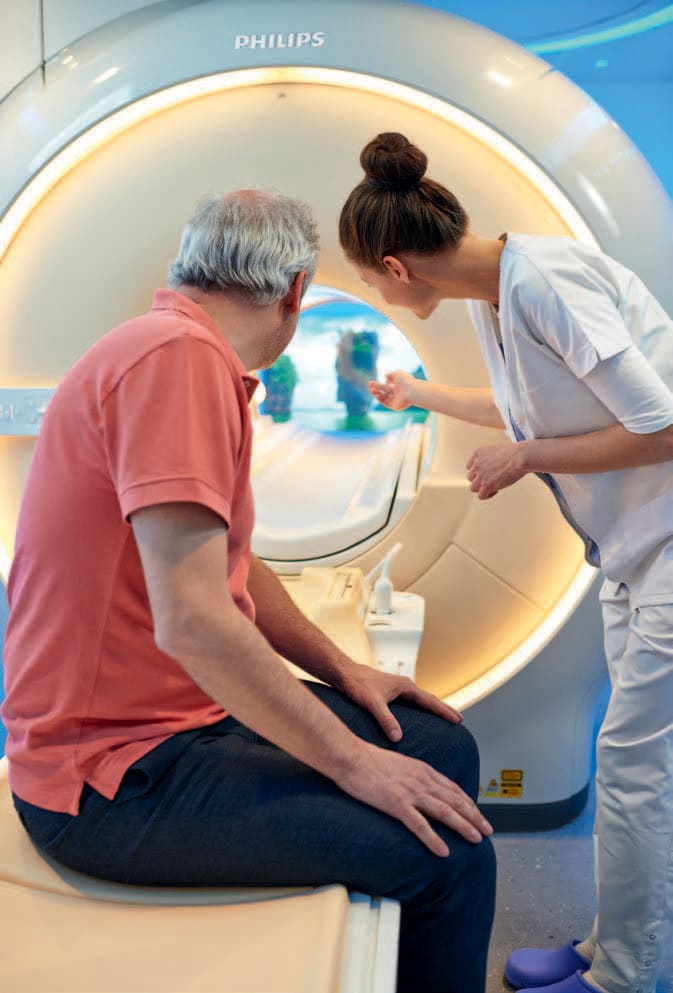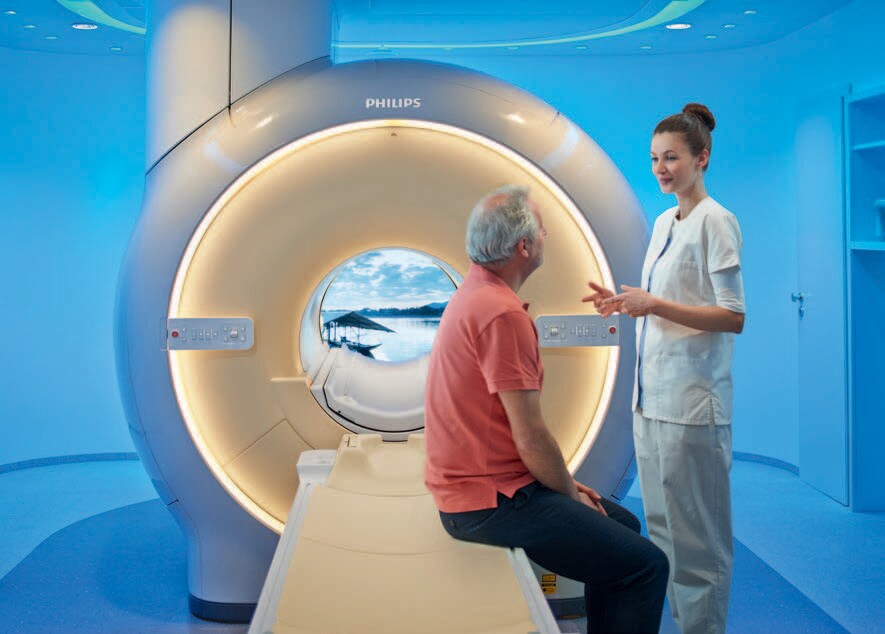FieldStrength MRI magazine
User experiences - July 2015
Having a clear vision on the importance of patient experience, Herlev Hospital acquired the differentiating Philips In-bore Solution to benefit their department efficiency.
Patient experience is a crucial factor for the successful operation of a radiology department. To that end, Herlev Gentofte University Hospital (Denmark) has added the Patient In-bore Solution to its Ingenia 3.0T system. Patients are positive and the MRI staff sees these features help calm patients, reducing motion-related problems and providing excellent images.
“Our staff members understand that a comfortable patient is key for a successful scan.”

Michel Christian Nèmery, MD
Michel Christian Nèmery, MD, is neuroradiologist and chairman of the Department of Radiology at Herlev Gentofte University Hospital. He is an innovator, founder of the CT-innovation unit for user driven innovation in clinical practice, and chair of the Radiology Council of Region Hovedstaden.

Jeanette Brus Mortensen
Jeanette Brus Mortensen is department radiographer for the MRI department.
Focus on the patient’s experience to benefit robust imaging
Michel Christian Nèmery, MD, is chairman of the Department of Radiology at Herlev Hospital. “Patient satisfaction is very important to us. In our country discussions on including patient experience into reimbursement models are currently ongoing. We’re trying to move away from being a ‘disease repair shop’ to being a ‘temple of health’ as I sometimes call it. The MR suite with the Ambient Experience and the In-bore Solution is a substantial element in that change.” “We have the full Ambient Experience and Patient In-bore Solution on our Ingenia 3.0T. We’re also trying to improve waiting areas and the reception area. We’ve asked our patients to choose wall pictures, and we’re doing a fairly extensive remake with special lighting and the Luminous Textiles technology from Philips, and we are in the process of asking our patients what else they’d like to see there.” Dr. Nèmery says the staff members feel good doing their job in this appealing environment. “They understand that it’s important for patients to be treated with respect and attention. Most important, they realize that a comfortable patient is key for a successful scan.
An uncomfortable patient is likely to move and cause artifacts in MR images, so that a scan needs to be repeated. So our attention for patient experience is also meant to benefit image quality and even our efficiency.”
Helping patients feel comfortable in MRI
Dr. Nèmery describes what a patient experiences in their Ingenia 3.0T suite: “Already in the preparation room, MRI patients design their own scan experience. Via an iPad mounted on the wall, the patient can choose a theme for the Ambient and In-bore experience. Then as the door opens they enter the scanner room, which shows, for example, an underwater theme. Patients are typically surprised and our techs are pretty clear that this gives them something to talk about while handling the patient; it often is a ‘concern-breaker’.” “We are often able to bring patients into the scanner feet first, which adds to their comfort level. However, when patients have to be scanned head first, the In-bore Solution provides this special audiovisual experience to a patient lying in the bore. I’ve tried it myself and it’s quite impressive: your focus is really filled up with what’s on the screen.”
“Our attention for patient experience is also meant to benefit image quality and even our efficiency.”
“We’ve been using this for about five months now, and it’s very effective. For patients, it’s a great experience and at the same time a distraction if they’re nervous or feeling a little claustrophobic or just impatient.” Patient experience and department efficiency go together. Dr. Nèmery and his team conducted a survey of patients who were scanned with the In-bore Solution. “They said it’s lovely, calming and a positive distraction. About 30% said time went by quickly. One said peaceful. One patient said fairy-tale- like! So patients are very positive and ask for this scanner when they need to come back. And in the short time we’ve been using the In-bore Solution, our patients who underwent scanning before on other systems have said adding the In- bore Solution gave them a positive experience.” “My sincere impression is that we do reduce patient motion, we reduce cancellations, and we do reduce repeat sequences and non-completed studies. So you could say it also improves on our efficiency,” says Dr Nèmery.
Studies show fantastic results
Radiographer Jeanette Brus Mortensen confirms these findings. “We get very positive feedback from our patients. They say that it is calming and has a relaxing effect. Our patients feeling somewhat anxious become focused on something other than the fact that they are lying in a scanner. Our patient survey shows that over 90% of the patients indicated to have a better or much better comfort level with their in-bore experience.” “Most important, feeling relaxed helps patients lie still during the scanning, which helps reduce motion in images,” she says. “This helps in diagnosis and reduces the amount of times we have to retake shaken sequences. Our data demonstrate a significantly reduced number of interrupted scans (rescans) in the scanner room where the Patient In-bore Solution is installed – which directly contributes to a more predictable throughout.” “We compared the number of interrupted examinations before and after installation of the In-bore Solution and between the six scanners. These data show a significant reduction of interrupted exams from the Ingenia 3.0T scanner with the In-bore Solution.”

“By reducing patient motion, we also reduce repeat scans, waiting times, rescheduling and staff overtime.”

“When the patients feel relaxed, they lie still during scanning.”


“This reduces the amount of times we have to retake shaken sequences.”
Changing our patient approach
Dr. Nèmery says, “Before we had Ambient Experience and the In-bore Solution, we could choose medication or human coaching to try to calm patients and also children who needed that. Or sometimes we would invite a patient to see the scanner some days before their exam, or we would offer a scan in our open scanner, the Panorama HFO.” “Some patients turn out to be not able to complete the scan in the open system. We have had a few examples of such patients who were then invited for a relaxed conversation and a look at the Ingenia with Ambient Experience and the In-bore Solution. Although it may not work for every patient, most of these patients did actually manage to get scanned there.”
A differentiator for the hospital
The focus on patient experience has helped the Herlev Hospital Department of Radiology to differentiate itself from others in the region.
“We do get patients who ask to be referred to us, and who are very explicit about having recommendations from family or friends or have heard about it on TV or Facebook or other media – we try to get it out there, because it looks beautiful and it represents that we take patient experience seriously.” “For us, there’s no question that it adds value,” Dr. Nèmery concludes. “Previously we could only try to comfort patients and cut down exams to go quickly. Now, the In-bore Solution introduces an element of surprise that generates an opportunity to break a train of thoughts, to distract patients in a good way, and help the techs handle the patients with care and give them a good experience. It enables patients to be active participants in their imaging by empowering them to design their own scan experience.” “This has a huge effect on our department. If we manage to reduce patient motion with the In-bore Solution, we also reduce repeat scans, waiting times, rescheduling and staff overtime. It helps us be more efficient while getting the high quality images we need.”
Results from this facility are not predictive of results in other facilities. Results in other facilities may vary.
Subscribe to FieldStrength
Our periodic FieldStrength MRI newsletter provides you articles on latest trends and insights, MRI best practices, clinical cases, application tips and more. Subscribe now to receive our free FieldStrength MRI newsletter via e-mail.
Stay in touch with Philips MRI

